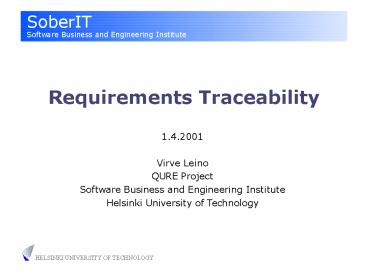Requirements Traceability - PowerPoint PPT Presentation
Title:
Requirements Traceability
Description:
Definition of requirements traceability. Benefits of ... tools to be used ... practices are taken into use. SoberIT. Software Business and Engineering ... – PowerPoint PPT presentation
Number of Views:105
Avg rating:3.0/5.0
Title: Requirements Traceability
1
Requirements Traceability
1.4.2001 Virve Leino QURE Project Software
Business and Engineering Institute Helsinki
University of Technology
2
Contents
- Definition of requirements traceability
- Benefits of requirements traceability
- Factors affecting the need for traceability
- Traceability classes and relation types
- Techniques to document traceability
- Tools to document traceability
- Tasks to implement traceability
- Lessons learned in QURE -project
3
Requirements traceability
- A requirement is traceable if you can discover
- who suggested the requirement,
- why the requirement exists,
- what requirements are related to it and
- how it relates to other information such as
systems design, implementation and documentation.
4
Benefits of Requirements Traceability
- Traceability helps in
- Requirements change management
- Validation and reuse of requirements
- Understanding how and why the system meets the
needs of the stakeholders
5
Factors affecting the need for traceability
- Type of the system
- Estimated system lifetime
- Number of requirements
- Size of the project team
- Level of organizational maturity
- Specific customer requirements
6
Traceability classes 1/2Pre- and
post-traceability
Pre-traceability
Post-traceability
Origins of requirements
System process artifacts
Requirements
7
Traceability classes 2/2 Forward and backward
traceability
Forward traceability
Origins of requirements
System process artifacts
Requirements
Backward traceability
8
Traceability relation types
Rationales
1) requirement-source 4) requirement-requirement
2) requirement-rationale 5)
requirement-component 3) requirement-people 6)
requirement-verification
9
Techniques to Document Traceability Information
1/3
- 1. Identifiers
- 2. Attributes
- 3. List
- 4. Table
- example of each technique follow...
10
Techniques to document 2/3
1. Requirement-requirement information documented
using requirements identifiers
2. Requirement-source and requirement-verification
documented using requirements attributes
11
Techniques to document 3/3
3. Requirement-component information documented
using list
4. Requirement-component information documented
using table
12
Tools to Document Traceability Information
- General purpose tools (eg. spreadsheet programs,
word processors, hypertext editors) - suitable for small and short term projects
- not sufficient for extensive requirements tracing
purposes - Requirements management tools
- suitable for projects producing large and complex
systems - require investments (eg. licences, training
end-users, system maintenance, consultation)
13
Tasks to Implement Traceability
- Analyze the companys need for traceability
- Define which traceability relations should be
documented - Select techniques and tools to be used
- Choose when, by whom and to where information
should be documented - Ensure that practices are taken into use
14
Lessons Learned in QURE -project
- Post-traceability
- many prerequisites
- clearly stated requirements, components and
verificatíon-cases - tool support is often needed to document it
- Pre-traceability
- first traceability that companies could benefit
from - easy to document (compared post-traceability)
- tool support is not needed































